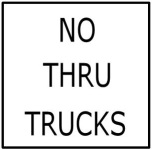Through Truck Prohibitions
Section 14-298 of the General Statutes of Connecticut (CGS) grants authority to the Office of the State Traffic Administration (OSTA) to prohibit through truck traffic of streets and highways within the limits of and under the jurisdiction of any city, town or borough within Connecticut for the protection and safety of the public.
Approved No Through Truck Routes Statewide
Requests for through truck prohibitions must be submitted from each Local Traffic Authority (LTA) from all municipalities along the requested route to the Executive Director of the OSTA for review and consideration. See "Through Truck Prohibition Investigations" below for more information.
Sections of streets and highways where through truck traffic is prohibited is only identified by the following black and white regulatory sign:

A "Thru Truck" is a truck which travels from a point outside of the limits of a city, town, or borough in Connecticut through such city, town, or borough without any scheduled stop in such locality. Any truck originating or having a destination within a city, town, or borough where any through truck prohibition has been established is not subject to such prohibition within that city, town, or borough where the truck originates or has a destination within.
Information Regarding "No Truck" Prohibitions
The No Trucks symbol sign  and the "No Trucks" text sign
and the "No Trucks" text sign  are more restrictive than a through trucks prohibition. The No Trucks sign prohibits, in addition to tractor-trailers, delivery vehicles (i.e. package/moving, oil, propane, etc.) and personally/commercially owned trucks from use on the segment of street or highway for which the signs are posted. There are no exceptions to this restriction.
are more restrictive than a through trucks prohibition. The No Trucks sign prohibits, in addition to tractor-trailers, delivery vehicles (i.e. package/moving, oil, propane, etc.) and personally/commercially owned trucks from use on the segment of street or highway for which the signs are posted. There are no exceptions to this restriction.
The definition of a truck was established by Section 14-1 of the CGS, as follows:
"(94) 'Truck' means a motor vehicle designed, used or maintained primarily for the transportation of property."
Through Truck Prohibition Investigations
Once a formal request for a through truck prohibition has been made from an LTA to the OSTA, an investigation is conducted. The initial part of the investigation is to determine if the street or highway is geographically located such that it could be utilized as a through truck route. If it is, then a study is conducted to determine if through trucks should be prohibited for the protection and safety of the public. This includes field measurements of the width of the street or highway, number and severity of curves and grades, sight line restrictions, roadside character and development, number and character of intersecting streets and highways, traffic control devices, volume and character of traffic, and established speed limits.
If the investigation indicates that the street or highway may not be adequate for through trucks, then a reasonable alternate route must be available before a through truck prohibition will be pursued. If a prohibition were enacted without a more acceptable route, trucks would be forced to utilize other streets and highways that are less suitable.
After the study has been completed, the city/town’s LTA (or authorities if there is more than one city/town) are contacted regarding the findings. All cities and towns affected must be in agreement before a through truck prohibition can be enacted, but a through truck prohibition can be denied without city/town agreement.
Truck Prohibitions by Weight Class Ordinance
Trucks may be prohibited by weight class on city/town-maintained roads by a town ordinance. In such cases, signs bearing the legend "NO THRU TRUCKS" or "THRU TRUCKS PROHIBITED" shall not be used.
A city/town may not enact any ordinances precluding trucks from local roads if they become de facto through truck prohibitions. The local road must meet the following criteria to ensure a de facto through truck prohibition would not be created by enaction of such an ordinance:
- Roadway must be located geographically such that it is not a viable through truck route.
- Roadway must be town owned along the entire length.
- No portion of roadway may be a state highway.
- Limited access highway ramp must not connect along any segment of roadway.
- Entire roadway must be located within the city/town limits.
To limit truck traffic on local roadways, towns may install a sub-plate with the legend "Exempt Delivery Or Service on This Street" underneath the weight limit sign. This would effectively prohibit local trucks from using the roadway, unless they have a scheduled delivery or service on said roadway.
City/Town officials should act cautiously when enacting such ordinances, because trucks may be diverted to less suitable roads.
For further information, please contact:
Office of the State Traffic Administration
Phone: (860) 594-3020
Fax: (860) 594-2552
Email: DOT.OSTA@ct.gov

